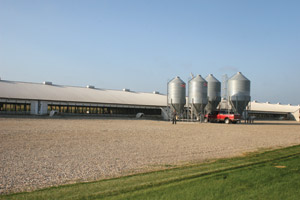
Iowa’s Kelly Farms and Minnesota’s M&J Farms both received the 2007 Port Industry Environmental Steward Award.

Loren Keppy uses a three-bay compost pile to manage his operation’s mortalities, which are mixed with materials he gets from a nearby horse farm and the shavings from a local logging mill.
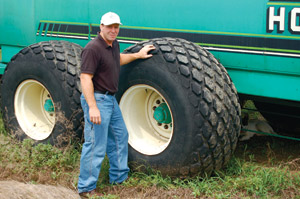 During manure application on the Keppy farm, tankers are brought out to the field and filled via manure pumped from the operation’s earthen basin. During manure application on the Keppy farm, tankers are brought out to the field and filled via manure pumped from the operation’s earthen basin. |
Two award-winning farmers talk about their different manure application styles
Iowa’s Kelly Farms and Minnesota’s M&J Farms both received the 2007 Port Industry Environmental Steward Award. They are both contract pig farms, and both are proactive when it comes to manure management. But when it comes to manure application, their individuality shines through.
Keppy Farm
Loren Keppy’s farm differs quite a bit from Haupert’s. Loren and his father farm a little over 900 acres near Durant, Iowa.
In 1995, Loren built two 1,000-head barns – each approximately 200-feet long by roughly 50-feet wide – for his 2,000 head feed-to-finish operation. He has a pull plug system and under each barn are eight pits, each two feet deep.
“I pull them once a month,” says Loren. “And then we add some fresh water and add Pit Remedy (for odor control). The additive seems to be working well. It helps with odor and it breaks down the solids a little more quickly.”
The additive also helps the manure flow more easily to an earthen basin, which is roughly 150-feet by x180-feet and holds well over 750,000 gallons.
Loren says they pump from the basin once a year in the fall.
“Usually we wait until the soil temperature gets below 55 degrees (Fahrenheit). And we treat (the manure) just like a regular anhydrous fertilizer. We don’t want to lose any of it, and usually the fall is when the time allows.”
Spreading
Instead of driving tankers down the road, and dealing with traffic, broken hitches and other issues, Loren typically lays a hose from the basin to the field. “Then we’ll put two Houle chopper pumps in the basin, one to agitate and one to pump. The manure is sent directly to the fields and that saves on time and fuel and machinery.”
Normally, Loren runs the hose out less than mile from the pit and the application will depend on the crop rotation and the manure management plan. Loren uses Kappler Farm Inc., a custom applicator, and they are able to pump between 20,000 to 30,000 gallons per hour and finish the job in about two days.
 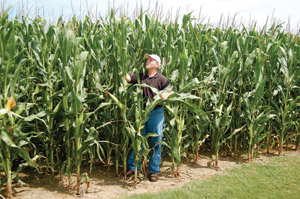
Keppy has experienced increased yields to his soybean and corn crops by using hog manure.
 Loren Keppy uses a pull plug system on his farm that is treated with a pit additive once a month after the pits are emptied. The additive helps to keep odors down and assists with manure flow. Loren Keppy uses a pull plug system on his farm that is treated with a pit additive once a month after the pits are emptied. The additive helps to keep odors down and assists with manure flow.
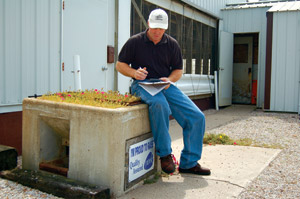 Manure application on Keppy’s farm is dependent on the crop rotation and the operation’s manure management plan. Manure application on Keppy’s farm is dependent on the crop rotation and the operation’s manure management plan.
Manure from the Keppy barns flows to an earthen basin, which is roughly 150-feet by x180-feet and holds well over 750,000 gallons. |
It’s an ideal process for the Keppy farm. Kappler brings tanks out to the fields, which are constantly being filled from the basin. “We have a load stand in the fields and we just drive under it and load it,” Loren says. “We’ve done it this way for three or four years now. It seems to work the best of everything we’ve tried. It preserves our nutrients and gets the job done quickly, safely and efficiently.”
The farm has experienced multiple benefits from spreading manure, including saving money. “With the price of commercial fertilizer, it makes this an invaluable asset to our farm,” Loren says. “We’re typically saving around $50 an acre. That was last year’s prices; who knows what it’s going to be this next year.”
Bringing down odor with oats
Keeping odor down is always an issue. Keppy’s farm is only a mile and a half from the town of Durant and about three-quarters of a mile from Interstate 80, and neighbors are within a half mile. Despite the close neighbors, he hasn’t had any complaints about odor.
One of the ways the operation has been able to reduce odors is by covering the manure basin with oat straw. “It not only reduces the odors,” he says, “it also preserves the nutrients. Unfortunately, the company that did it has gone out of business. It’s not very easy to find somebody that does that. There’s special equipment to blow big round bales on that.
“There are times when there are odors but we try to keep them down to as little as possible,” he says. “We try to take every step we can.” That includes everything from cleaning up spills to washing down fans regularly.
Composting
Another step they take to combat odors is composting. “It keeps any mortality odors down to practically zero,” says Loren.
The farm has a three-bay compost, approximately 36-feet by 12-feet. Loren mixes the mortalities with materials he gets from a nearby horse farm and the shavings from a local logging mill.
“You have to keep the sawdust moist enough to create heat,” he says. “But once you pile it, it really fires.” Within three months, there are no signs of the mortalities and the compost is then used as fertilizer in the fall on the fields, Loren says.
Better crops
Keppy raises corn and soybeans and, like Haupert, sees better results using the pig manure versus commercial fertilizers.
“You can tell exactly the line where you stop using manure as fertilizer compared to commercial fertilizer. I think it has to do with all the micronutrients you’re getting in the manure that you just can’t go out and purchase easily.”
Loren says he wouldn’t do anything differently. Although he admits the pull plug system is more labor intensive, he enjoys the better air quality that comes with it.
M&J Farms
Mike Haupert, owner of M&J Farms, has been a contract finisher for Christensens Farms for five years. Before that, he worked with his cousin, Jeff Boz, on his nearby 3,000-acre farm.
|
Mike Haupert, owner of M&J Farms, has been a contract finisher for Christensens Farms for five years.

The barn is comprised of three rooms with each holding approximately 1,000 pigs each.
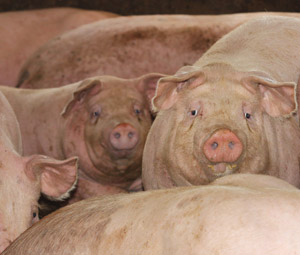 Odor hasn’t been an issue at M&J Farms, in part because additives are used in the pigs’ feed to keep odors down. Odor hasn’t been an issue at M&J Farms, in part because additives are used in the pigs’ feed to keep odors down.
|
Mike has a nine-acre site and a large barn – 51-feet x 477-feet – to house his 3,120 head. “It’s basically three rooms that hold approximately 1,000 pigs apiece,” says Mike.
When Mike had the barn built five years ago, there were a number of county ordinances he had to meet, including: being 300 feet from a creek; a half a mile from neighbors; a mile from town, among others. “It was actually kind of hard to find a site that met all the requirements when you started looking,” recalls Mike.
Custom Application
There’s an eight-foot pit running underneath the entire length of the barn. When it’s time to apply — normally once a year — four agitators are placed throughout the pit. Once the manure is agitated, it’s pumped straight from the pit to the fields.
How much to spread and where, Mike says, he leaves up to an expert. “My cousin has an agronomist and we go by everything he recommends. We give him the manure and soil samples and he puts it all together and that’s what we put on.”
Mike uses Scotts’ Liquid Handling out of Tracy, Minn., to do the application. The company has been applying at M&J Farms since Mike started up his operation. “I think last year he pumped about 1,200,000 gallons,” says Mike.
Bring in the TerraGator
When it’s time to spread Ron [owner of Scott’s Liquid Handling] takes a TerraGator out to the field. “Then Ron loads the semis in my yard and he hauls them out to the field,” says Mike. “He pumps the contents of the semis into a large tank out there. And then the TerraGator just pumps out of the tank. It works pretty slick.”
Mike’s manure plan requires that he apply on 700 acres, and he’s currently applying on around 900 acres on his cousin’s farm just to be safe. All of the acreage falls within one to two miles of Mike’s farm.
Once the manure is applied, Mike goes out and reworks the field — again just to be safe. “We wait about two days, and then we chisel plow the whole field again. And that’s just to make sure that we don’t lose any of the nutrients.”
Great fertilizer
Crops have improved since they’ve moved from synthetic fertilizers to spreading hog manure, says Mike. “The first year, the corn crop will be between 8 and 10 percent better (using) hog manure than it is (using) commercial fertilizer,” says Mike. “The next year, we rotate the crop with beans, and the beans will be about five percent better than ground that just had commercial fertilizer.”
Mike says the manure from his barn is high in nutrients based on the samples Ron takes. He attributes that to the fact that he doesn’t use much water in his barn for washing. “I’ve got a big pressure washer, so evidentially I don’t use as much water as a lot of other people,” says Mike. “So the manure is pretty high for nutrients.”
Besides being great fertilizer, the situation is also saving Mike’s cousin some money. “I sell it to my cousin for 75 percent of commercial value. That’s kind of a going rate within a mile or two.”
Odor under control
Mike says odor hasn’t been an issue at the farm, in part because Christensens Farms puts some additives in the pigs’ feed to keep odors down. But Mike also does his part as well. He’s planted a number of trees and kept areas wild to buffer the smell. “I think that trees helps a lot because it forces the air up. So it gets up in the atmosphere and dissipates.”
When asked if he would change anything about the system in place on the farm today, Mike says he wouldn’t change a thing. “If I could, I’d expand,” he admits with a laugh.

